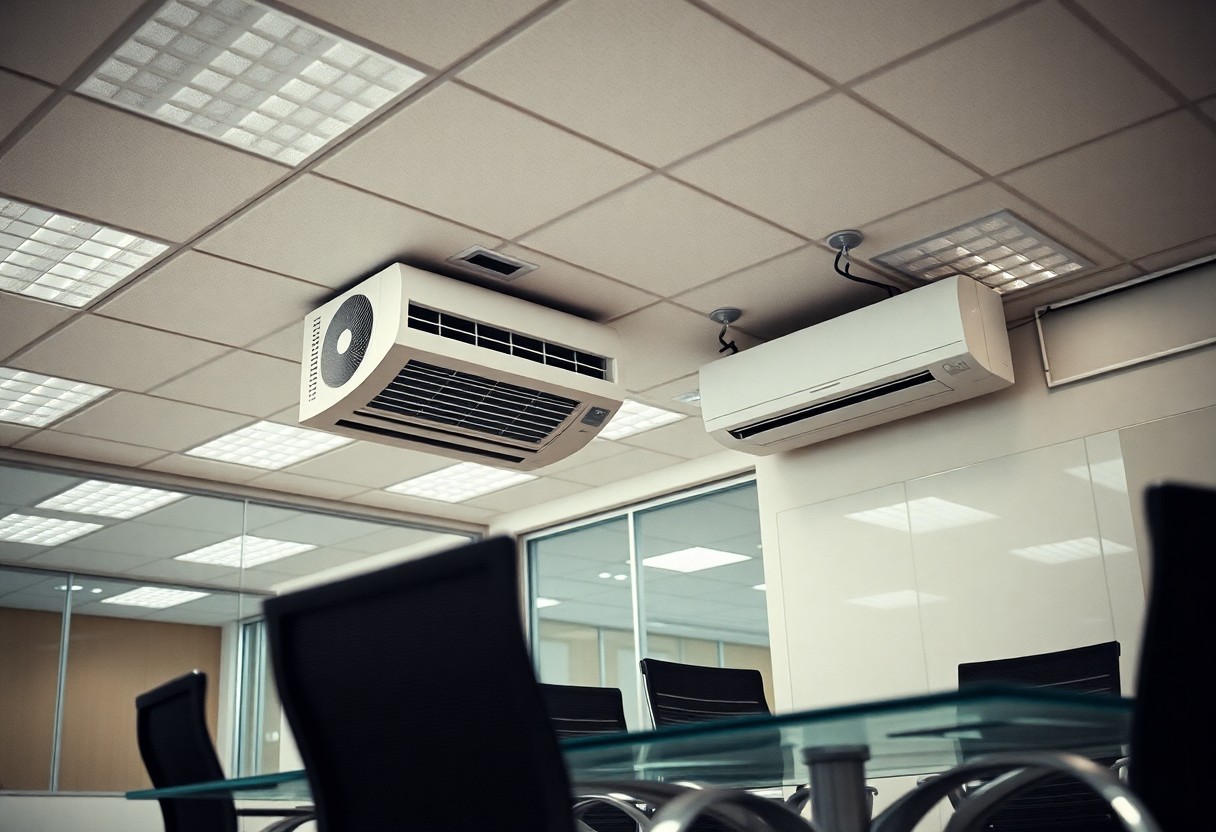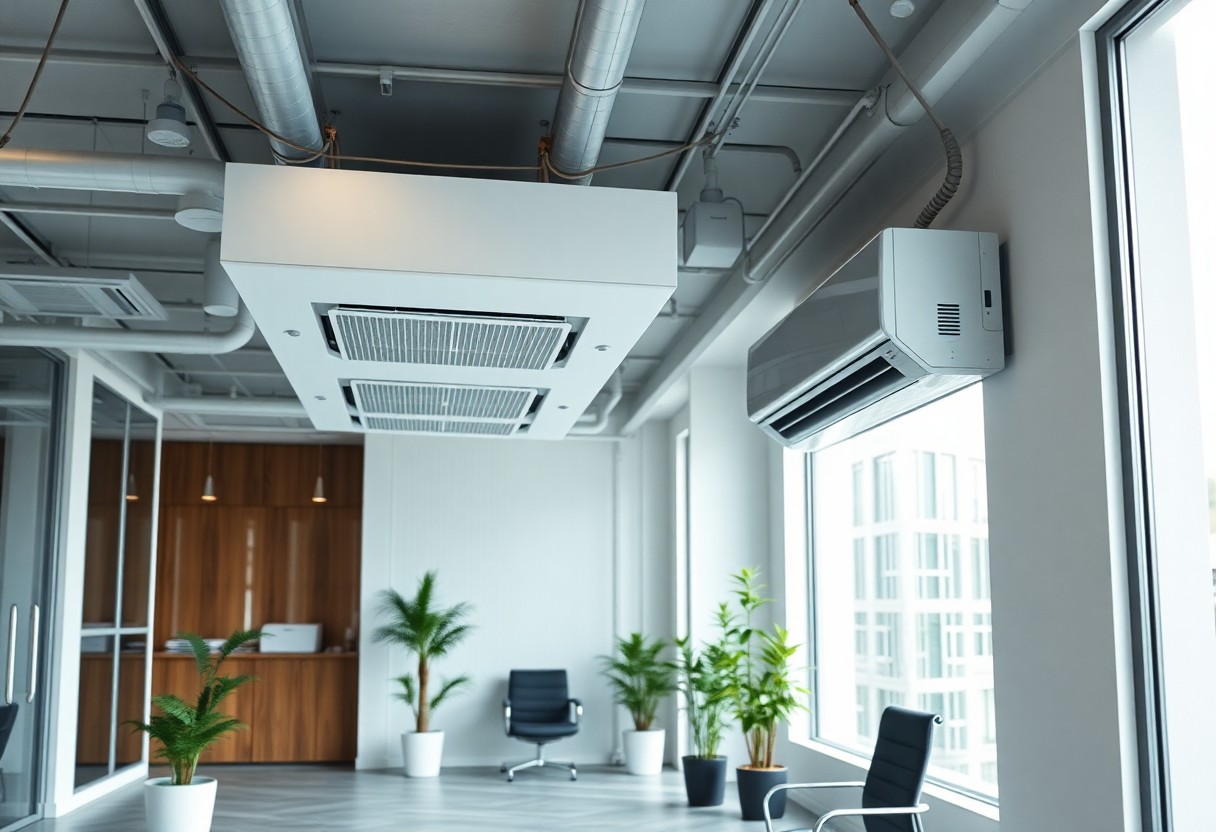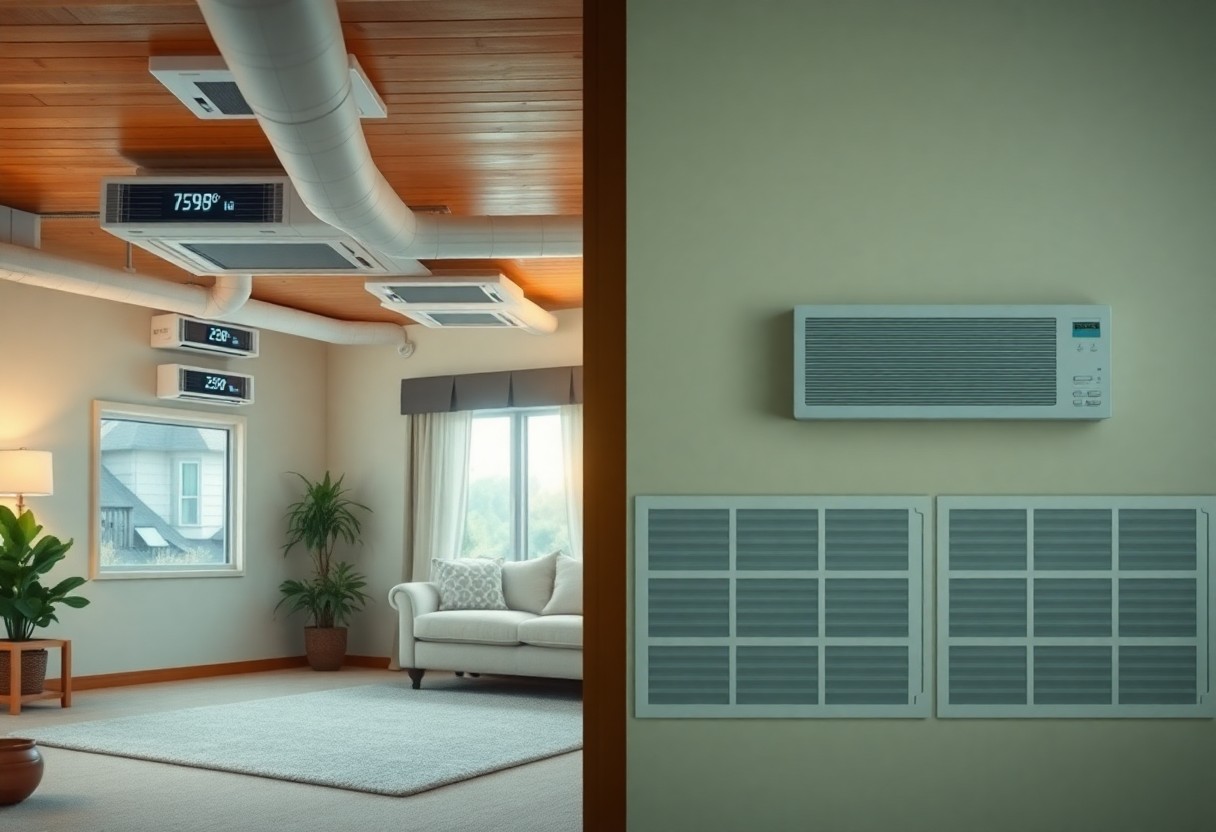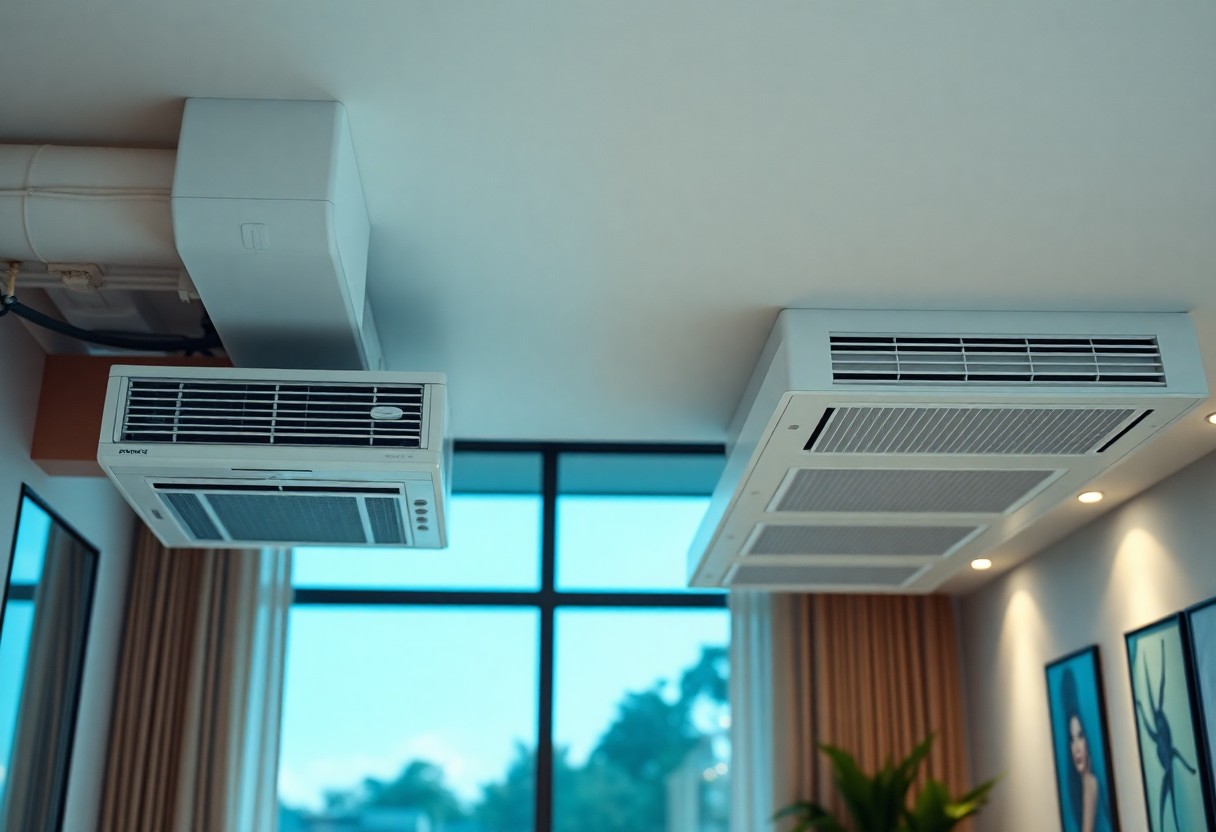You need to consider your options when it comes to cooling your office space effectively. Cassette and wall-mounted air conditioning systems each offer distinct advantages and features tailored to different requirements. Understanding their differences can help you make an informed choice that aligns with your space layout, cooling needs, and budget. This post will provide insights into both options, allowing you to determine which system is best suited for your office environment.
Key Takeaways:
- Cassette air conditioners provide more uniform cooling across larger spaces due to their installation in the ceiling.
- Wall-mounted units are typically easier and less expensive to install, requiring minimal structural changes.
- Cassette systems often have a higher initial cost but can offer better aesthetics and save space on the floor.
- Wall-mounted units can be more energy-efficient for smaller areas and provide localized cooling.
- Maintenance and accessibility may vary, with wall-mounted units being easier to access for routine service.
The Architectural Appeal of Cassette Air Conditioning
Cassette air conditioning units blend functionality with modern design, making them a popular choice for office spaces seeking a polished aesthetic. Their installation in the ceiling allows for an unobtrusive cooling solution that enhances the visual appeal of your workspace. This approach not only maintains an uncluttered look but also optimizes airflow, ensuring a consistent and comfortable temperature throughout the area while complementing contemporary architecture.
Seamless Integration with Modern Office Designs
Discreet Aesthetics and Space Optimization
With cassette air conditioning, you gain the advantage of minimal visual impact, maintaining a clean and modern look in your office. They occupy less space than traditional wall-mounted units, which can obstruct your interior design choices. This allows for better furniture placement and greater flexibility in layout options, making efficient use of your available area while keeping the focus on your business operations.
By opting for cassette air conditioning, you not only enhance the aesthetics of your office but also optimize valuable space. Unlike bulky wall-mounted systems that can disrupt your interior flow, cassette units provide a sleek solution that blends seamlessly into your ceiling. This design strategy allows you to arrange workstations and meeting areas more effectively, contributing to a stylish and functional environment that supports productivity. Your workspace can maintain an airy feel while ensuring optimal comfort, proving that you can indeed have both style and efficiency.
Wall Mounted Units: An Old Favorite with New Benefits
Wall mounted air conditioning units have long been a staple in the office environment, offering a straightforward solution for temperature control. With advancements in technology, modern wall units deliver energy efficiency and smart features, enhancing your workspace comfort without sacrificing quality. These units are designed for easy installation, making them accessible for various office layouts. Additionally, their compact size allows for flexibility in positioning, ensuring optimal air circulation throughout your office.
Cost-Effectiveness and Accessibility
Wall mounted units are often more budget-friendly than their cassette counterparts, both in initial investment and operational costs. Their straightforward installation process reduces labor expenses, making them a practical choice for small to mid-sized offices. Additionally, businesses can easily find a variety of models that fit different energy efficiency standards, enabling you to select options that meet your budget while maintaining comfort in your office space.
Simplified Maintenance and Repair Options
Wall mounted units are known for their accessible design, making maintenance and repairs less daunting. With external components easily reachable, routine tasks such as filter changes and inspections can be performed without extensive downtime. This accessibility not only saves you money on maintenance services but also empowers your team to manage basic upkeep, ensuring consistent performance.
Efficient maintenance practices for wall mounted air conditioning units can prolong their lifespan and improve energy efficiency. For instance, regularly cleaning filters enhances air quality and reduces strain on the unit, which can decrease your energy bills significantly. Many models also come equipped with self-diagnostic features, enabling you to identify issues before they escalate. With less complex technology than cassette systems, wall units often require fewer specialized tools and parts, allowing local technicians to conduct repairs swiftly and effectively, keeping your office cool without long interruptions.
Performance Metrics: Comparing Efficiency and Cooling Power
Efficiency and Cooling Power Comparison
| Feature | Wall Mounted Units | Cassette Units |
|---|---|---|
| Energy Efficiency Ratio (EER) | 11-14 | 12-16 |
| Cooling Capacity (BTU/hr) | 6000-24000 | 12000-36000 |
| Cost per KWh | Varies by region | Varies by region |
Energy Consumption and Environmental Impact
Energy consumption for both air conditioning types can significantly impact your office's utility bills and carbon footprint. Wall-mounted units typically have a moderately efficient EER ranging from 11 to 14, while cassette units can reach EERs of 12 to 16, making them more energy-efficient. Choosing a high-efficiency model reduces your energy expenses and supports sustainability efforts by decreasing greenhouse gas emissions.
Noise Levels and Employee Comfort
Noise levels play a critical role in employee comfort, influencing productivity and mental well-being. Wall-mounted units generally produce sound levels around 35-50 decibels, while cassette units can be quieter at approximately 30-45 decibels. Quieter operating units help create a more conducive work environment, free from distracting noise, ensuring employees remain focused on their tasks.
A quieter air conditioning unit not only enhances comfort but also fosters a better workplace atmosphere. For instance, workplaces that incorporate cassette units report higher employee satisfaction, as the reduced noise allows for clearer communication and fewer disruptions. The lower decibel levels of cassette air conditioning units can also improve overall workplace morale and lead to increased productivity over time, making them a worthwhile investment in an office setting.

Installation Considerations: Navigating the Technical Aspects
Understanding the installation requirements for both cassette and wall-mounted air conditioning units aids in making an informed decision. Factors such as existing infrastructure, power supply needs, and drainage systems play significant roles. You'll need to evaluate the layout of your office space, ensuring that airflow is optimal and potential obstacles, like beams or ducts, are accounted for before proceeding.
Space Requirements and Placement Strategies
Calculating your available space is vital for both types of units. Wall-mounted systems typically require less overhead clearance but need adequate wall space for installation. In contrast, cassette units can be integrated into ceilings, allowing for more versatility and a streamlined aesthetic. Proper placement ensures efficiency, so prioritize locations that maximize both cooling distribution and accessibility for maintenance.
Installation Timelines and Associated Costs
Installation timelines vary significantly between the two systems. Wall-mounted units may take just a few hours, while cassette units can require a couple of days due to the ceiling work involved. Costs also differ; wall-mounted systems usually have lower initial costs (averaging $200-$1,200) compared to cassette units which can range from $1,000 to $3,000. Additional labor costs for ductwork and electrical modifications should be considered, impacting the overall budget and time spent.
For example, if you're considering a cassette system, the installation may demand specialized labor for the ceiling integration, which can increase both your timeline and costs. Opting for a wall-mounted unit may allow you to skip some of the complexity, leading to quicker installation. Conducting a thorough cost-benefit analysis will help you assess which installation suits your timeframe and budget best while ensuring that your cooling needs are met efficiently.

Making the Right Choice: Balancing Needs and Preferences
Selecting between cassette and wall-mounted air conditioning involves understanding your unique office needs, preferences, and budget constraints. Consider factors such as aesthetic appeal, functionality, and maintenance requirements. Your decision should reflect not only immediate comfort but also long-term efficiency and the overall environment you aim to create in your workspace.
Assessing Office Size and Layout
Your office size and layout significantly influence the effectiveness of air conditioning systems. In open-plan spaces, a cassette system may provide better air distribution, while smaller rooms might benefit from the focused cooling of wall-mounted units. Evaluating these physical aspects will enable you to choose a climate control solution that ensures consistent comfort across your office.
Weighing Initial Costs Against Long-Term Value
Initial purchase and installation costs can vary widely between cassette and wall-mounted units. While cassette systems may demand a higher upfront investment due to more extensive installation requirements, they often lead to reduced energy bills and improved efficiency over time. Assessing total cost of ownership—including maintenance and energy consumption—offers a clearer picture of your long-term financial commitment.
Investing in a cassette air conditioning system usually presents a higher initial cost, such as $2,500 to $5,000 for installation. However, with energy-efficient models, operational costs can decrease by 30% compared to traditional units. Moreover, durability and performance longevity typically result in fewer repairs. In contrast, a wall-mounted system may be appealing for its lower upfront costs, generally around $1,500 to $3,000, but operational costs and potential replacement expenses should also factor into your final decision, illustrating that the cheapest option now may not always create the best value in the long run.
Summing up
Considering all points, you should evaluate your office space needs carefully when choosing between cassette and wall-mounted air conditioning systems. Cassette units offer a more discreet installation and potentially better air distribution, making them ideal for larger areas. On the other hand, wall-mounted units are easier to install and maintain, suitable for smaller spaces. Assess factors such as room size, aesthetic preferences, and budget to make an informed decision that enhances your office's comfort and efficiency.
FAQ
Q: What are the main differences between cassette and wall-mounted air conditioning units?
A: Cassette units are installed in the ceiling and distribute air downward, while wall-mounted units are affixed to the wall and blow air directly outward. Cassette units offer a more discreet appearance, while wall-mounted units are often easier to install.
Q: Which type of air conditioning unit provides better coverage in a large office space?
A: Cassette units generally provide better coverage in larger spaces due to their central location in the ceiling, allowing for a more even distribution of air across a wider area compared to wall-mounted units.
Q: What are the installation requirements for cassette versus wall-mounted air conditioning units?
A: Cassette units require a drop ceiling or sufficient ceiling space for installation and often involve more extensive ductwork. Wall-mounted units need less installation work but require suitable wall space and support for mounting.
Q: Which option is more energy-efficient for cooling office spaces?
A: Energy efficiency can vary by model, but generally, cassette units tend to be more efficient for larger spaces due to better air distribution and reduced hot spots, while wall-mounted units can be efficient for smaller areas.
Q: What are the maintenance considerations for cassette and wall-mounted air conditioning units?
A: Both types require regular maintenance, but cassette units may need occasional access to the ceiling for filter cleaning or repairs. Wall-mounted units are typically easier to access for routine maintenance, such as filter changes and cleaning.






